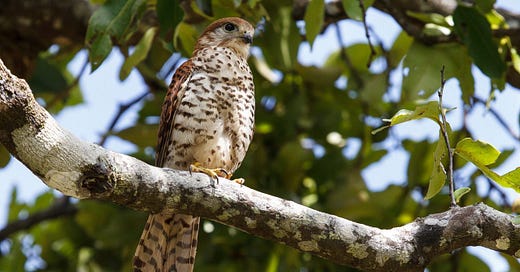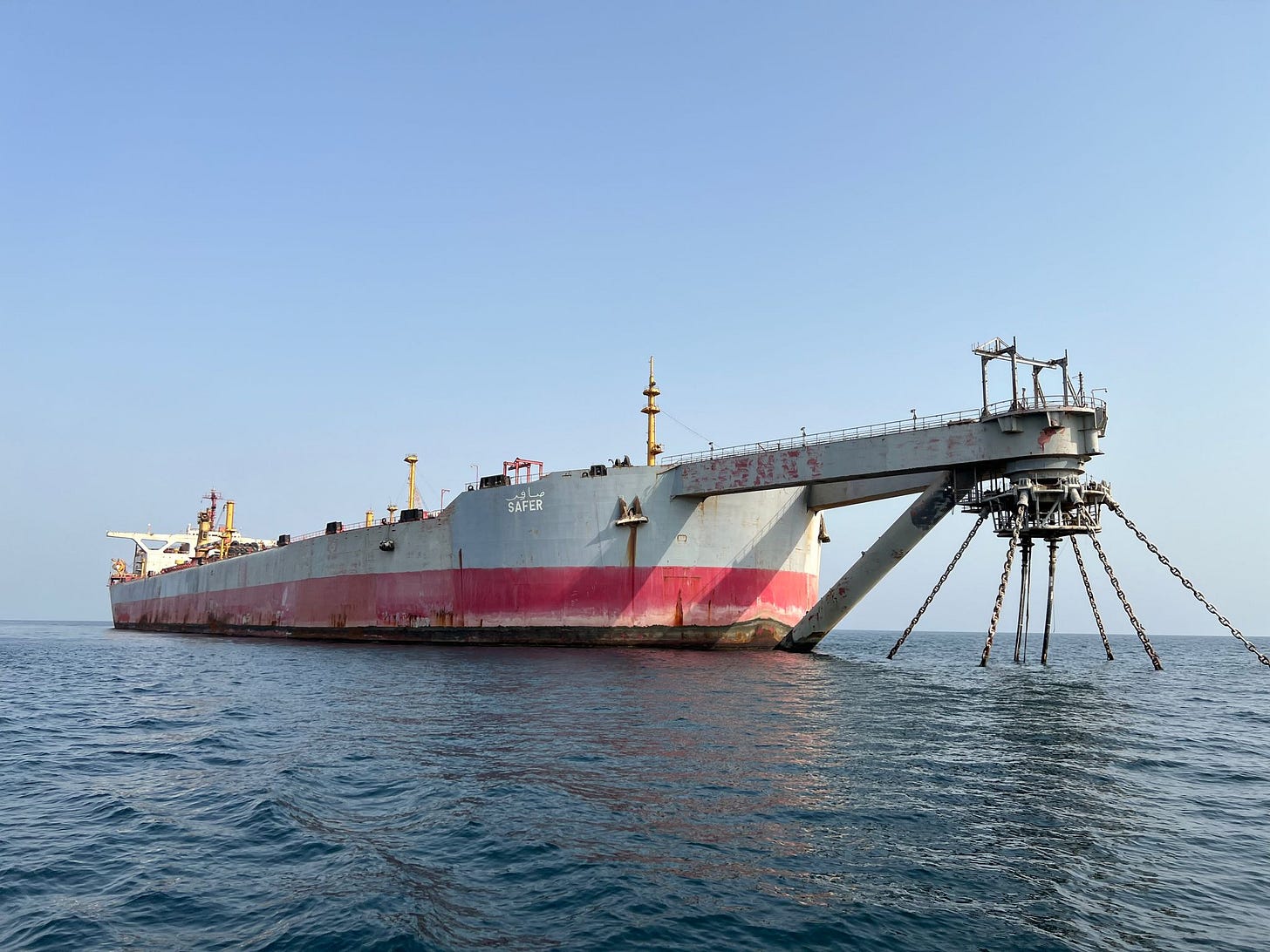The Weekly Anthropocene, August 2 2023
Offshore wind and transmission line progress in Maine, an ecological time bomb being defused off the coast of Yemen, the saga of the Mauritius kestrel and the ravenala tree, and more!
Maine
Maine’s elongated 2023 state legislative session came to a close in late July. This writer is proud of the steady, sensible decarbonization progress in their home state!
Governor Janet Mills signed into law a landmark offshore wind procurement bill, which includes a commitment for the state of Maine to buy up to 3 gigawatts (3,000 megawatts) of offshore wind power by 2040, as well as provisions to support the development of offshore wind supply chains and an offshore wind port in Maine. This creates a strong economic tailwind for the burgeoning Maine offshore wind industry! The federal Bureau of Ocean Energy Management will hold their first Gulf of Maine offshore wind lease auctions in 2024.
A new bus rapid transit system is in-development for Greater Portland, Maine’s biggest urban area.
President Biden visited Maine as part of his “Bidenomics” tour, highlighting the outstanding success of his ARP, CHIPS, and IRA investments that have brought US investment in manufacturing to the highest levels since the 1950s.
Maine has successfully amended its mining laws to allow quarrying of the rich lithium-bearing spodumene deposit found in Newry, integrating “really careful fixes” proposed by the Maine Department of Environmental Protection. The Pine Tree State could soon be producing lithium to help decarbonize the world!
The Maine Legislature voted to give preliminary approval for a vital 1,200-MW transmission line enabling the proposed King Pine Wind project, an excellent extra-large 1,000 MW wind farm to be built on Aroostook County timberlands starting in 2028.
After a lengthy and frustrating political and legal conflict1, the New England Clean Energy Connect transmission line will resume construction on August 3, 2023. When complete, it will bring surplus electricity from Quebec hydropower dams to the New England grid, helping displace fossil fuels.
Governor Janet Mills has signed into law a bipartisan transportation budget with an innovative new method for funding road maintenance (historically dependent on gas tax revenues) in the age of EVs. This is pretty niche, but it’s an understatedly impressive piece of lawmaking. The Maine Department of Transportation will now receive 40% of the money from sales taxes on vehicles as well as 40% of sale and use taxes collected by the Bureau of Motor Vehicles. These changes should bring in $200 million in the next two years, which Maine DOT plans to spend in on paving, plowing, bridge repair, and other vital maintenance. This is a well-crafted policy that could be a model for the nation, as many jurisdictions are wondering how to pay for roads without a gas tax. Some figures have proposed a punitive “anti-EV tax” applied to electric vehicles only, and Maine’s model is a far superior alternative.
Yemen
For years, The Weekly Anthropocene has shared reporting on the international problem of the FSO Safer, an oil tanker carrying about 1.1 million barrels of crude abandoned off Yemen in 2015 due to the outbreak of the Yemeni Civil War. It’s gone without maintenance for eight years now (due in large part to the Houthi rebels controlling access to the area), and is at imminent risk of exploding and/or cracking open, which would cause an immense, multifaceted crisis. An oil spill four times larger than the Exxon Valdez in this key region of the Red Sea would imperil global shipping routes, rare coral reefs that appear to have evolved valuable heat-resistance genes critical in the age of climate change, clean water for the Saudi city of Jeddah that relies on a desalination plant, and the food security of millions of Yemenis who rely on shipped-in provisions, in general adding a whole bunch of Very Bad new problems in the world. Check out this article for a more in-depth breakdown.
And now, it’s weeks away from no longer being a threat. On July 25, 2023, after years of patient diplomatic and technical work, a United Nations-led international team2 began siphoning the oil out of the decaying Safer into a large UN-owned oil tanker renamed the Yemen. It’s projected to be a 19-day operation, and will probably be complete by mid-August. Every day that goes by for that period, you can wake up each morning with the warm, fuzzy feeling of knowing that there’s less oil in the decaying death-ship than there was the day before.
The Weekly Anthropocene wants to take a moment, as an inhabitant of Earth, to deeply thank everyone involved in this project. They’re basically defusing a giant ship-sized bomb that’s threatening global commerce, the Red Sea’s unique coral reefs, and the survival of millions of people. In the middle of rebel-held waters.
Reading the news and press releases around the operation gives a sense of the audacity of what’s being attempted here, and the bravery of those doing it. To quote from a Grist article: “The Safer could, with no notice whatsoever, crack like a walnut or erupt at the slightest spark” and “Outside experts note that either vessel would be within range of Houthi artillery or drones. U.N. officials say they have no choice but to trust everyone involved not to target it.” And “It’s also suspected that the waters off Yemen have been mined during the conflict.”
How is this not bigger news?!
In any case: good job, human civilization. The world has gotten its act together and coordinated an expensive, difficult and dangerous operation, working for the common good of protecting biodiversity, commerce, and human well-being from an avoidable, foreseeable threat. Great news!
Mauritius
The Mauritius kestrel came to the edge of extinction in 1974, when only four individuals were left after decades of losses to DDT and feral cats. A robust captive breeding program3 brought their population back from the brink to over 800 free-living birds by 2010. Now, their numbers have declined again, to perhaps 350 individuals, as habitat destruction lowered the population of their gecko prey.
Interestingly, the fan-like “traveler’s palm” ravenala trees, native to Madagascar and introduced to Mauritius, have become a key support to help the remaining raptor population thrive again. Insects love their nectar and fruits, and geckos love the insects, colonizing ravenala trees en masse. Geckos now provide up to 70% of the kestrels’ diet, and kestrel nests surrounded by ravenalas produced more fledglings.
This newsletter has long called for a reevaluation of the “invasive species” concept to recognize that the overwhelming majority of introduced species have neutral to positive results on the local ecosystem4, including many that have been described as “worst of the worst” invaders. For example, when working in Madagascar, this writer learned that critically endangered greater bamboo lemurs commonly use the berries of the soapbush (Clidemia hirta), as a “weaning food” to help their babies transition from mother’s milk to bamboo. Soapbush is a plant not native to Madagascar that has been ranked by the IUCN as among the one hundred worst invasive species in the world, yet it plays a key role in helping an imperiled primate survive. There are many more such examples of mutually beneficial interactions with what this newsletter prefers to call “immigrant species”, turning the invasive-species cliché on its head. The story of the Mauritius kestrels, the geckos, and the ravenala trees now stands among them!
Here’s the full story, as reported by The Weekly Anthropocene in March 2022.
“In November 2021, Mainers voting in a referendum decided to shut down the New England Clean Energy Corridor (NECEC) transmission line project, a proposed power line from hydroelectric dams in Quebec through Maine to provide low-carbon baseline power to the Massachusetts grid. The NECEC project was supported by both Governor Janet Mills and the Biden Administration, but, very disappointingly, was opposed by a shocking coalition of natural gas companies and some deeply misguided Maine environmental groups…Calpine, a company that owns a major natural gas plant in the town of Westbrook, Maine…invested $3.2 million in the Super PAC that funded anti-NECEC ads and Maine ballot signature drives to get the anti-NECEC referendum going.”
A court case later found that the NECEC project had a right to continue the construction project it had begun before the referendum cut it off. It’s good news for decarbonization that NECEC is going forward now!
Funded by donations from a range of governments, including the United States, UK, Canada, and many European and Middle Eastern countries.
The project of famed conservationist and memoirist Gerald Durrell, among others.
A few invasive species do have clearly harmful impacts, like the brown tree snake in Guam and many cases of feral cats and rats on isolated islands. However, a nativist paradigm in “invasion biology” has long described all introduced species as “invasive” and harmful by default, an increasingly senseless position to take as climate change causes thousands of species to shift their ranges. Also, estimates of economic harms caused by invasive species often include the cost of removing them, in a too-common example of circular reasoning.







I ❤️ the article about the
strels and lemurs both being saved by immegrant species!? Who knew? Excellent reporting!
Thanks for the summary of Maine news, Sam. I didn't know we'd revised some laws so that lithium could get mined in Newry! Wow, that's huge. And great news that Janet signed the windpower bill into law. She's a mixed bag when it comes to energy: her opposition to Our Power and citizen-owned energy distribution and her support of CMP is very discouraging.